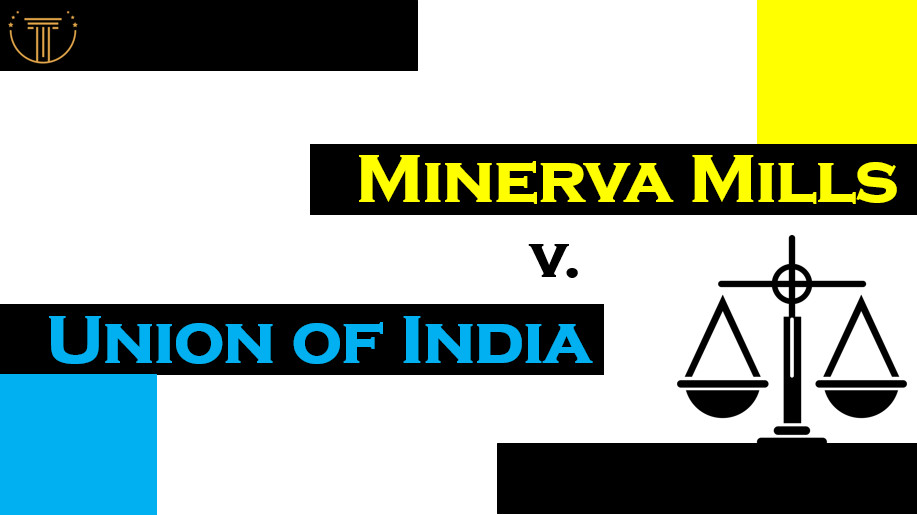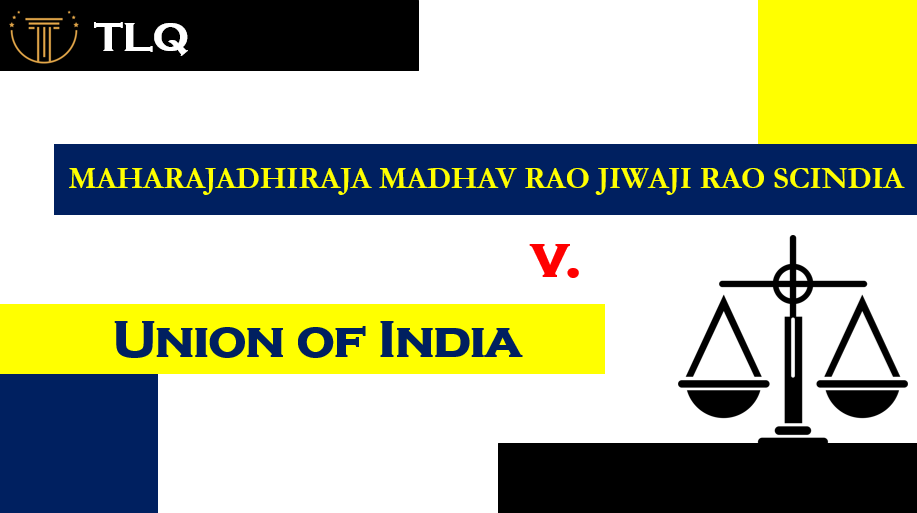Published on 11th April 2025
Authored By: Suneho Dutta
Department of Law, University of Calcutta
Introduction
The landmark case of Keshavananda Bharati versus the State of Kerala stands as a pivotal moment in Indian constitutional law, addressing the essential principles of constitutional supremacy and the fundamental rights of citizens. Originating in the early 1970s, this legal battle emerged when
Keshavananda Bharati, a prominent religious leader, challenged the validity of certain amendments to the Indian Constitution that sought to limit the power of judicial review and alter the basic structure of the Constitution itself. This case not only encapsulated the tension between the legislature and judiciary but also sparked a profound discourse on the balance of power within a democratic framework. The Supreme Courts ruling established the doctrine of the “basic structure,” asserting that while amendments can be made to the Constitution, the fundamental framework ensuring democracy, justice, and the rule of law must remain intact. Thus, this case remains crucial in understanding the evolution of constitutional interpretations in India.
Overview of the Keshavananda Bharati case and its significance in Indian constitutional law
The Keshavananda Bharati case, decided by the Supreme Court of India in 1973, is pivotal in the evolution of Indian constitutional law, particularly regarding the balance of power between the legislature and the judiciary. The ruling established the basic structure doctrine, asserting that while Parliament has the authority to amend the Constitution, it cannot alter its fundamental framework. This landmark decision surfaces in the larger context of evolving policies that prioritize social equity amidst a backdrop of economic liberalization, as discussed in (Fischer et al.). The courts stance reflected an innate tension between legislative power and constitutional limits, especially in light of increasing developmental projects impacting land rights. The Keshavananda Bharati ruling has since become a cornerstone for judicial review in India, reinforcing the judiciary’s role in safeguarding the democratic principles enshrined within the Constitution. This case remains illustrative of the ongoing dialogue surrounding judicial activism and legislative authority.
Background of the Case
The case of Keshavananda Bharati versus the State of Kerala emerged against the backdrop of significant constitutional changes and judicial interpretations during the early years of Indian democracy. The case primarily revolved around the validity of certain amendments made to the Constitution that sought to limit the rights of property owners, which Keshavananda Bharati argued infringed upon the fundamental rights guaranteed by the Constitution. This conflict highlighted the critical tension between the Directive Principles of State Policy, as outlined in the Constitution, and the fundamental rights enshrined therein, both of which were intended to guide India’s socioeconomic development. The Supreme Court, in response, engaged in a profound analysis of the constitutional framework, ultimately ruling that while amendments could be enacted, they could not alter the essential features of the Constitution itself, thereby establishing a principle that would influence Indian jurisprudence significantly. This ruling underscored the judiciary’s role in safeguarding democracy amid societal aspirations for justice and equality, revealing the evolving nature of public accountability and legal interpretation in India.
Historical context and events leading to the filing of the case
The historical context surrounding the filing of the Keshavananda Bharati case is rooted in India’s tumultuous journey toward constitutionalism and the ongoing struggle over the balance of power between state and individual rights. Following independence in 1947, India faced a series of challenges involving the interpretation of constitutional mandates and the extent of government authority. Key events, such as the first amendment in 1951, which aimed to address concerns related to property rights, illustrated the tension between legislative action and constitutional interpretation. This dynamic reflected broader global trends where courts in federal systems often play crucial roles in determining the strength of individual liberties relative to governmental power. Moreover, the concept of constituent power gained traction during India’s anticolonial struggle, as it emphasized the agency of the people in shaping their governance, a principle that underscored the philosophical debates leading up to the case.
Key Legal Issues
The case of Keshavananda Bharati versus the State of Kerala primarily revolves around the balance of power between the legislature and the judiciary in safeguarding constitutional principles. The Supreme Courts landmark decision asserted the doctrine of the basic structure of the Constitution, which prevents Parliament from altering fundamental features that could compromise the Constitutions integrity. This ruling highlights key legal issues regarding the interpretation of fundamental rights and directive principles, which, while aimed at achieving socioeconomic justice, need to be harmoniously reconciled within the constitutional framework. The ongoing debate about judicial activism versus legislative sovereignty emerges here, as the Court addresses the vagueness of its interpretation of rights, particularly in light of its expanding jurisdiction over socioeconomic rights. Furthermore, while laws have been continuously amended to protect rights and dignity, the effectiveness of these legal frameworks remains in question amid rising social issues, underscoring the delicate interplay between law and societal change.
Examination of the fundamental rights and the basic structure doctrine
The examination of fundamental rights within the context of the basic structure doctrine is crucial to understanding the implications of the Keshavananda Bharati versus the State of Kerala case. This landmark decision established that while the Parliament has wide powers to amend the Constitution, such powers cannot extend to altering its basic structure. This doctrine ensures that essential democratic principles, including fundamental rights, remain inviolable in the face of political and legislative changes. As highlighted in current scholarship, the Supreme Court has broadened the interpretation of Article 21, linking it to the right to live with dignity and making several Directive Principles justiciable, thereby intertwining socio-economic rights with fundamental freedoms. Furthermore, the dynamic tension between judicial activism and parliamentary sovereignty necessitates careful balancing, particularly as India confronts the challenges posed by economic liberalization while preserving its constitutional commitment to social equity.
Implications of the ruling on future constitutional interpretations and amendments
The Keshavananda Bharati ruling significantly reshaped the landscape of constitutional interpretation in India, establishing the basic structure doctrine as a foundational principle. This landmark decision asserts that while Parliament holds the power to amend the Constitution, such amendments cannot alter its core principles, including fundamental rights and the essence of democracy. The implications of this ruling are profound, as it creates a framework within which future constitutional interpretations must operate, ensuring that any legislative changes remain consistent with the Constitutions foundational ethos. Consequently, this doctrine serves as a safeguard against potential overreach by the legislature, thereby reinforcing the judiciarys role as a guardian of constitutional integrity. As amendments are proposed in the future, the Keshavananda ruling will act as a pivotal reference point for courts, influencing both legal arguments and legislative strategies, ultimately ensuring a balance between parliamentary sovereignty and constitutional supremacy.
Conclusion
The case of Keshavananda Bharati versus the State of Kerala fundamentally reshaped the Indian constitutional landscape by establishing the basic structure doctrine. This legal principle asserts that certain core tenets of the Constitution cannot be altered or destroyed by amendments, thereby safeguarding fundamental rights and reinforcing the balance of power among governmental institutions. The implications of this landmark ruling extend beyond mere constitutional interpretation; they reflect a broader commitment to socioeconomic justice, encapsulated in Article 21’s evolution towards a right to live with dignity. Moreover, the Indian judiciary’s proactive stance resonates with the need for public accountability and the assertion of collective welfare over individual interests, as highlighted by recent developments in environmental jurisprudence. Ultimately, the Keshavananda Bharati ruling underscores the importance of maintaining constitutional legitimacy, emphasizing that public institutions must provide transparent and accessible reasons for their decisions, thereby fostering democratic engagement and trust among citizens.
References
- Abeyratne, Rehan. “Socioeconomic Rights in the Indian Constitution: Toward A Broader Conception of Legitimacy” BrooklynWorks, 2014, doi: https://core.ac.uk/download/228595077.pdf
- Fischer, Alexander. “Which Road to Social Revolution? Liberalization and Constitutional Reform in India” Heidelberg Papers in South Asian and Comparative Politics, 2017, doi: https://core.ac.uk/download/631108187.pdf
- Fischer, Alexander. “Which Road to Social Revolution? Liberalization and Constitutional Reform in India” Heidelberg Papers in South Asian and Comparative Politics, 2017, doi: https://core.ac.uk/download/631108187.pdf
- Patgiri, Dristirupa. “The Law of Eminent Domain and Forced Displacement in India” Centre for Publications, CHRIST (Deemed to be University), 2024, doi: https://core.ac.uk/download/617889202.pdf
- Abeyratne, Rehan. “Socioeconomic Rights in the Indian Constitution: Toward A Broader Conception of Legitimacy” BrooklynWorks, 2014, doi: https://core.ac.uk/download/228595077.pdf
- Borpatragohain, R C. “Safeguarding the Dignity of Women under the Criminal Law Amendment Act 2013-A Critical Analysis” ‘ACCB Publishing’, 2013, doi: https://core.ac.uk/download/295492786.pdf
- Aroney, Nicholas, Kincaid, John. “Courts in Federal Countries” ‘OAPEN Foundation’, 2020, doi: https://core.ac.uk/download/478117922.pdf
- Tundawala, Moiz. “In the shadow of swaraj: constituent power and the Indian political” 2018, doi: https://core.ac.uk/download/210995167.pdf
- Abeyratne, Rehan. “Socioeconomic Rights in the Indian Constitution: Toward A Broader Conception of Legitimacy” BrooklynWorks, 2014, doi: https://core.ac.uk/download/228595077.pdf
- Abraham, C. M.. “Environmental Justice in India: The Manifestation of Neo-Dharmic Jurisprudence in Postmodern Public Law.” 2025, doi: https://core.ac.uk/download/334948365.pdf
- Abeyratne, Rehan. “Socioeconomic Rights in the Indian Constitution: Toward A Broader Conception of Legitimacy” BrooklynWorks, 2014, doi: https://core.ac.uk/download/228595077.pdf
- Abraham, C. M.. “Environmental Justice in India: The Manifestation of Neo-Dharmic Jurisprudence in Postmodern Public Law.” 2025, doi: https://core.ac.uk/download/334948365.pdf


